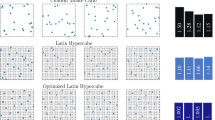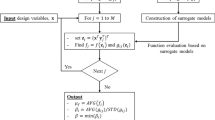Abstract
Given the limitations of Latin hypercube design in constrained design space, Latin hypervolume designs with good space-filling and noncollapsing properties are developed in this paper. In the proposed method, the value of the design points in each dimension is based on the hypervolume instead of the coordinate axis length, enabling the generated design to have the space-filling property. To address the challenge of precisely obtaining the hypervolume in high-dimensional and irregular design spaces, Monte Carlo sampling is introduced to approximate the hypervolume. In addition, a constrained simulated annealing algorithm is presented for the proposed method, with an acceleration module to speed up the process of searching for a feasible design. The experiments on benchmark numerical examples illustrate that the proposed method is considerably better compared with the other two methods. Moreover, the proposed method is applied to an engineering modeling scenario to analyze the impact of cracks on the physical properties of an aircraft model. The results show that the proposed method generates a more desirable distribution of cracks and is more suitable for complex situations in practical engineering. Source code is available at https://github.com/Pang-Yong/LHVD-OLHVO.













Similar content being viewed by others
Data availability
All data are available from the author upon reasonable request.
References
Viana FAC (2016) A tutorial on Latin hypercube design of experiments. Qual Reliab Eng Int 32:1975–1985. https://doi.org/10.1002/qre.1924
Pang Y, Wang Y, Sun W, Song X (2022) OTL-PEM: an optimization-based two-layer pointwise ensemble of surrogate Models. J Mech Des 144:1–14. https://doi.org/10.1115/1.4053011
Lai X, Wang S, Guo Z, Zhang C, Sun W, Song X (2021) Designing a shape-performance integrated digital twin based on multiple models and dynamic data: a boom crane example. J Mech Des Trans ASME. https://doi.org/10.1115/1.4049861
Zhai Z, Li H, Wang X (2020) An adaptive sampling method for Kriging surrogate model with multiple outputs. Eng Comput 38:277–295. https://doi.org/10.1007/s00366-020-01145-1
Zhou Q, Wu J, Xue T, Jin P (2021) A two-stage adaptive multi-fidelity surrogate model-assisted multi-objective genetic algorithm for computationally expensive problems. Eng Comput 37:623–639. https://doi.org/10.1007/s00366-019-00844-8
Tenne Y (2015) Initial sampling methods in metamodel-assisted optimization. Eng Comput 31:661–680. https://doi.org/10.1007/s00366-014-0372-z
Stinstra E, Stehouwer P, Den Hertog D, Vestjens A (2003) Constrained maximin designs for computer experiments. Technometrics 45:340–346. https://doi.org/10.1198/004017003000000168
McKay MD, Beckman RJ, Conover WJ (2000) A comparison of three methods for selecting values of input variables in the analysis of output from a computer code. Technometrics 42:55–61. https://doi.org/10.1080/00401706.2000.10485979
Meng D, Li Y, He C, Guo J, Lv Z, Wu P (2021) Multidisciplinary design for structural integrity using a collaborative optimization method based on adaptive surrogate modelling. Mater Des 206:109789. https://doi.org/10.1016/j.matdes.2021.109789
Tian J, Tan Y, Zeng J, Sun C, Jin Y (2019) Multiobjective infill criterion driven Gaussian process-assisted particle swarm optimization of high-dimensional expensive problems. IEEE Trans Evol Comput 23:459–472
Trinh MC, Jun H (2021) Stochastic bending and buckling analysis of laminated composite plates using Latin hypercube sampling. Springer, London. https://doi.org/10.1007/s00366-021-01544-y
Lekivetz R, Jones B (2015) Fast flexible space-filling designs for nonrectangular regions. Qual Reliab Eng Int 31:829–837. https://doi.org/10.1002/qre.1640
Aziz A (2019) EC-030 statistical analysis of various optimal latin hypercube designs, pp 187–190
Borkowski JJ, Piepel GF (2009) Uniform designs for highly constrained mixture experiments. J Qual Technol 41:35–47. https://doi.org/10.1080/00224065.2009.11917758
Van Dam ER, Husslage B, Den Hertog D, Melissen H (2007) Maximin Latin hypercube designs in two dimensions. Oper Res 55:158–169. https://doi.org/10.1287/opre.1060.0317
Morris MD, Mitchell TJ (1995) Exploratory designs for computational experiments. J Stat Plan Inference 43:381–402. https://doi.org/10.1016/0378-3758(94)00035-T
Zhu H, Liu L, Long T, Peng L (2012) A novel algorithm of maximin Latin hypercube design using successive local enumeration. Eng Optim 44:551–564. https://doi.org/10.1080/0305215X.2011.591790
Bates SJ, Sienz J, Toropov VV (2004) Formulation of the optimal Latin hypercube design of experiments using a permutation genetic algorithm. Collect. Tech Pap. AIAA/ASME/ASCE/AHS/ASC Struct. Struct. Dyn. Mater. Conf. 7:5217–5223. https://doi.org/10.2514/6.2004-2011
Aziz M, Tayarani MHN (2014) An adaptive memetic Particle Swarm Optimization algorithm for finding large-scale Latin hypercube designs. Eng Appl Artif Intell 36:222–237. https://doi.org/10.1016/j.engappai.2014.07.021
Fang K-T, Ma C-X, Winker P (2000) Centered $L_2$-discrepancy of random sampling and Latin hypercube design, and construction of uniform designs. Math Comput 71:275–297. https://doi.org/10.1090/s0025-5718-00-01281-3
Pholdee N, Bureerat S (2015) An efficient optimum Latin hypercube sampling technique based on sequencing optimisation using simulated annealing. Int J Syst Sci 46:1780–1789. https://doi.org/10.1080/00207721.2013.835003
Ye KQ, Li W, Sudjianto A (2000) Algorithmic construction of optimal symmetric Latin hypercube designs. J Stat Plan Inference 90:145–159. https://doi.org/10.1016/s0378-3758(00)00105-1
Liefvendahl M, Stocki R (2006) A study on algorithms for optimization of Latin hypercubes. J Stat Plan Inference 136:3231–3247. https://doi.org/10.1016/j.jspi.2005.01.007
Shang X, Chao T, Ma P, Yang M (2020) An efficient local search-based genetic algorithm for constructing optimal Latin hypercube design. Eng Optim 52:271–287. https://doi.org/10.1080/0305215X.2019.1584618
Chen RB, Hsieh DN, Hung Y, Wang W (2013) Optimizing Latin hypercube designs by particle swarm. Stat Comput 23:663–676. https://doi.org/10.1007/s11222-012-9363-3
Jin R, Chen W, Sudjianto A (2005) An efficient algorithm for constructing optimal design of computer experiments. J Stat Plan Inference 134:268–287. https://doi.org/10.1016/j.jspi.2004.02.014
Li W, Lu L, Xie X, Yang M (2017) A novel extension algorithm for optimized Latin hypercube sampling. J Stat Comput Simul 87:2549–2559. https://doi.org/10.1080/00949655.2017.1340475
Viana FAC, Venter G, Balabanov V (2012) An algorithm for fast optimal Latin hypercube design of experiments. Int J Numer Methods Eng. https://doi.org/10.1002/nme
Pan G, Ye P, Wang P (2014) A novel latin hypercube algorithm via translational propagation. Sci World J. https://doi.org/10.1155/2014/163949
Garud SS, Karimi IA, Kraft M (2017) Design of computer experiments: a review. Comput Chem Eng 106:71–95. https://doi.org/10.1016/j.compchemeng.2017.05.010
Wang Y, Xu B, Sun G, Yang S (2017) A two-phase differential evolution for uniform designs in constrained experimental domains. IEEE Trans Evol Comput 21:665–680. https://doi.org/10.1109/TEVC.2017.2669098
Mak S, Joseph VR (2018) Minimax and minimax projection designs using clustering. J Comput Graph Stat 27:166–178. https://doi.org/10.1080/10618600.2017.1302881
Petelet M, Iooss B, Asserin O, Loredo A (2010) Latin hypercube sampling with inequality constraints. AStA Adv Stat Anal 94:325–339. https://doi.org/10.1007/s10182-010-0144-z
Draguljié D, Dean AM, Santner TJ (2012) Noncollapsing space-filling designs for bounded nonrectangular regions. Technometrics 54:169–178. https://doi.org/10.1080/00401706.2012.676951
Fuerle F, Sienz J (2011) Formulation of the audze-eglais uniform Latin hypercube design of experiments for constrained design spaces. Adv Eng Softw 42:680–689. https://doi.org/10.1016/j.advengsoft.2011.05.004
Fuerle F, Sienz J (2013) Decomposed surrogate based optimization of carbon-fiber bicycle frames using Optimum Latin Hypercubes for constrained design spaces. Comput Struct 119:48–59. https://doi.org/10.1016/j.compstruc.2012.11.014
Wu Z, Wang D, Wang W, Zhao K, Okolo PN, Zhang W (2019) Space-filling experimental designs for constrained design spaces. Eng Optim 51:1495–1508. https://doi.org/10.1080/0305215X.2018.1542691
Chen RB, Li CH, Hung Y, Wang W (2019) Optimal noncollapsing space-filling designs for irregular experimental regions. J Comput Graph Stat 28:74–91. https://doi.org/10.1080/10618600.2018.1482760
Gendreau M, Potvin J-Y (2010) Handbook of metaheuristics: international series in operations research e management science
Suganthan PN, Hansen N, Liang JJ, Deb K, Chen YP, Auger A, Tiwari S (2005) Problem definitions and evaluation criteria for the CEC 2006 special session on constrained real-parameter optimization, Tech. Report, Nanyang Technol. Univ. Singapore, May 2005 KanGAL Rep. 2005005, IIT Kanpur, India, pp 1–24
Yang L, Lai X, He X, Li P, Sun W, Song X A Newton-Cotes-based online acceleration signal fast processing approach to obtain displacement for digital twin (in press)
Acknowledgements
This research is supported by the National Key Research and Development Program of China (No. 2018YFB1702502) and the National Natural Science Foundation of China (No. 52075068).
Author information
Authors and Affiliations
Corresponding author
Ethics declarations
Conflict of interest
The authors declared no potential conflicts of interest with respect to the research, authorship, and/or publication of this article.
Additional information
Publisher's Note
Springer Nature remains neutral with regard to jurisdictional claims in published maps and institutional affiliations.
Rights and permissions
Springer Nature or its licensor (e.g. a society or other partner) holds exclusive rights to this article under a publishing agreement with the author(s) or other rightsholder(s); author self-archiving of the accepted manuscript version of this article is solely governed by the terms of such publishing agreement and applicable law.
About this article
Cite this article
Pang, Y., Yang, L., Wang, Y. et al. A Latin hypervolume design for irregular sampling spaces and its application in the analysis of cracks. Engineering with Computers 39, 3509–3526 (2023). https://doi.org/10.1007/s00366-022-01769-5
Received:
Accepted:
Published:
Issue Date:
DOI: https://doi.org/10.1007/s00366-022-01769-5




